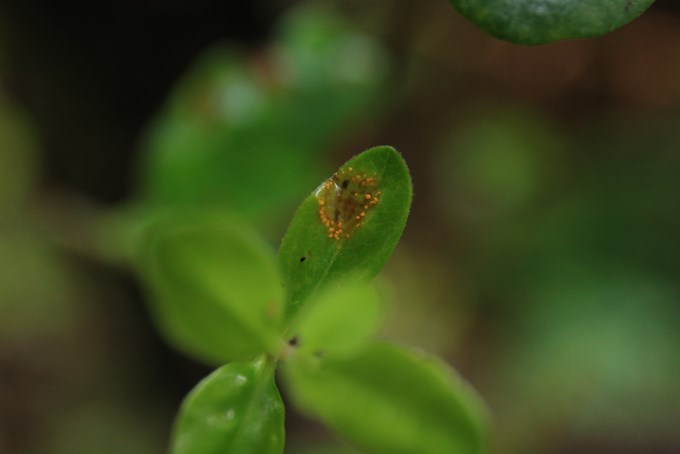Get the Myrtle Rust Reporter app
A new smartphone app has been developed to make it easier to report any sightings of myrtle rust. It is called Myrtle Rust Reporter and is freely available through the App Store and Google Play. You can take a picture and submit your record using the app, and when you contact MPI they will be able to use your app username to look up your recording and discuss your photo with you.
Find out more about Myrtle Rust Reporter
UPDATED Tuesday 28 November
A second discovery of myrtle rust has been made on ramarama plants at a private property in St Lukes.
This comes after the first finding of the fungal plant disease in the Auckland region last week in the Waimauku area of west Auckland.
Myrtle rust is a fungus that attacks and can potentially seriously affect myrtle species plants including some significant natives such as pōhutukawa, ramarama, mānuka and rātā.
The Ministry for Primary Industries (MPI) is leading the response and says so far it appears ramarama and pōhutukawa are the most susceptible species in New Zealand.
MPI myrtle rust response controller Dr Catherine Duthie says of the 136 locations now known to be infected, 90 per cent involve infection in ramarama or pōhutukawa plants.
“As with all our previous detections, we’ve placed movement controls on the new property to stop any myrtle plant material being moved off site,” she says.
“Our team on the ground will shortly remove all affected plants to contain any risk of spread.”
Dr Duthie says finding another infection in Auckland so soon after last week’s detection is disappointing but expected.
“While myrtle rust has been relatively dormant over the winter months we have been expecting new infections to be identified as the weather warms up and the fungus begins to release spores again.”
What to do if you see myrtle rust:
- Initial symptoms are powdery, bright yellow or orange-yellow pustules on leaves, tips and stems.
- Report any signs of the distinctive yellow fungus to MPI on 0800 80 99 66.
- Do not touch the plant or the rust, as this may spread it.
- If possible, take a photo of the plant and yellow patches and send the photo to MPI.
Find out more about myrtle rust at MPI
UPDATED 23 November
The fungal plant disease myrtle rust has been found for the first time in the Auckland region.
The Ministry for Primary Industries (MPI) says a serious infection of several hundred Lophomyrtus (ramarama) plants has been confirmed on a commercial plant production property in the Waimauku area of west Auckland.
Myrtle rust is a fungus that attacks and can seriously affect myrtle species plants including some significant natives such as pohutukawa, manuka, kanuka and rata.
MPI Myrtle rust response controller Dr Catherine Duthie says the facility owner reported suspected myrtle rust to MPI on Tuesday and MPI was able to confirm the infection late yesterday (Wednesday).
“We’ve placed movement controls on the property to stop any myrtle plant material being moved off site and a team is in place today to start removing infected plants.
“Visibly infected plants will be safely destroyed as quickly as possible and we will begin to check neighbouring properties to identify any other potential infections.”
Dr Duthie says the team is working closely with the owner to manage the infection in his plants which are grown for ornamental foliage.
“This is a significant new find given the new location and the extent of the infection.
“However, sadly, it is also an expected detection. While myrtle rust has been relatively dormant over the winter months we have been expecting new infections to be identified as we head into the warmer summer months and the fungus begins to release spores again.”
MPI is now considering the implications of the new find.
“It may mean that we have to review our tactics and prepare for a longer term approach to managing it in partnership with others including local authorities, iwi, plant production industry and interested individuals.
“We’ll be keeping people informed about any decisions and will provide the most up to date information about best practice in fighting this disease,” Dr Duthie says.
What to do if you see myrtle rust
The Ministry encourages everyone to keep an eye on myrtle species plants and report suspected myrtle rust disease to MPI on 0800 80 99 66.
Myrtle rust has previously been found in Taranaki, Te Puke, Waikato and Northland.
Get more information at mpi.govt.nz/myrtlerust


